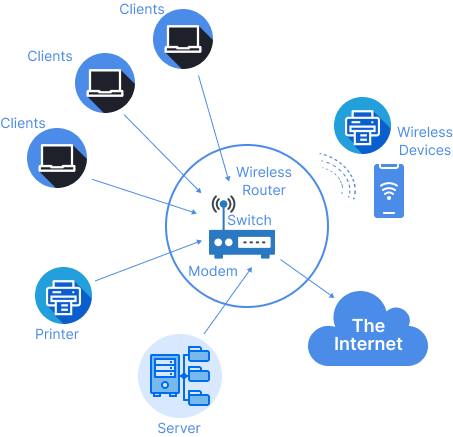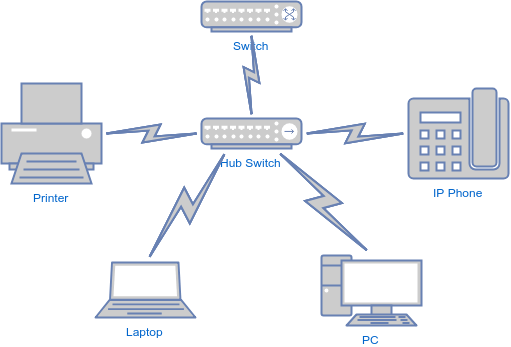
- The Basics of Computer Networks: An Overview
- Understanding How Networks Connect Devices
- Key Network Classifications: From Small to Large
- Building Blocks of a Network: Key Components
- The Journey of Data: How Networks Function
- Why Networks Matter: The Impact on Daily Life
- The Future of Networking Trends to Watch
- Conclusion
The Basics of Computer Networks: An In-Depth Exploration
In today’s fast-paced digital world, computer networks are indispensable to how we communicate, share data, and access information. Whether it’s sending an email, accessing a website, or using a mobile app, most of our daily activities rely on a seamless exchange of data across interconnected devices. But what exactly is a computer network, and how does it function? A computer network is essentially a system where multiple devices or computers are linked together to share resources and exchange data. Microsoft Azure Training can range from personal computers, smartphones, and printers to more specialized devices, such as servers or smart appliances. The connections between these devices enable them to communicate and collaborate, whether they’re in the same room or scattered across the globe. At the heart of a computer network are protocols and rules that govern how data is transmitted and received. These protocols ensure that data moves efficiently, securely, and without errors. Understanding these basic concepts is essential for anyone looking to comprehend the technology that powers today’s interconnected world.
Understanding the Fundamentals of Computer Networks
- At its core, a network is all about communication between devices. Just like how people need a common language to communicate with each other, devices need a set of standardized rules or protocols to communicate efficiently.
- Without these protocols, it would be impossible for computers, smartphones, or any other devices to understand each other, causing confusion and errors in data transmission.
- When you send data across a network, it doesn’t just travel as one large chunk of information. Instead, it gets broken down into smaller units called “packets.” Each packet of data contains a portion of the message along with information about where it’s headed.
- The packets follow a specific route across the network, and once they reach their destination, they are reassembled into the original message. Two of the most important protocols governing data transmission are the Transmission Control Protocol (TCP) and the Internet Protocol (IP).
- TCP ensures that data is sent and received accurately by managing the breakdown and reassembly of packets. IP, on the other hand, handles the addressing and routing, ensuring that each packet reaches its correct destination.
- Together, Cloud Computing Platforms and Services enable devices to communicate smoothly, even if they are spread across vast distances. Now, let’s dive deeper into the types of networks that exist and explore their purpose and size.

Unlock your potential in Azure with this Azure Training.
Key Network Classifications: From Small to Large
A Personal Area Network (PAN) is the smallest type of network. It is typically used to connect devices that are in close proximity to each other, such as a smartphone, laptop, or wireless headphones. PANs usually cover an area of just a few meters, and they’re typically wireless, relying on technologies like Bluetooth or infrared. These networks are ideal for individuals who want to sync their devices, transfer files, or connect peripherals like printers or speakers. A Local Area Network (LAN) is larger than a PAN but still operates within a limited geographic area, such as a home, office, or campus. LANs are essential for connecting computers, printers, and other devices within the same physical location, allowing for fast and efficient data transfer. One of the key advantages of LANs is their speed, as they can support high-bandwidth activities like file sharing, video conferencing, and gaming. The backbone of a LAN usually consists of Ethernet cables or Wi-Fi technology, both of which provide reliable connections. Routers and switches play a critical role in managing the flow of data within a LAN, ensuring devices can communicate with one another efficiently. AWS Rekognition How Face Recognition Works cover much larger areas than LANs, often spanning entire cities, countries, or even continents. WANs are essential for connecting multiple LANs over long distances, allowing businesses, governments, and individuals to communicate and share information globally. The most well-known example of a WAN is the internet itself, which connects millions of devices worldwide. WANs use a variety of technologies, such as leased lines, fiber optics, and satellite links, to transfer data across vast distances. Routers and other specialized network devices manage the flow of data, ensuring packets are routed through the most efficient path to their destination. Metropolitan Area Networks (MANs) cover a geographical area that is larger than a LAN but smaller than a WAN, typically spanning a city or a large campus. MANs are commonly used by large organizations, educational institutions, or government agencies to connect different locations within a city or metropolitan area. These networks provide high-speed data transfer and are often built using fiber-optic cables, which offer fast and reliable connectivity. MANs are particularly useful for businesses or institutions that need to share large volumes of data quickly between different locations within the same city. They are also frequently used by internet service providers to offer high-speed internet connections to consumers.
Dive into Microsoft Azure by enrolling in this Azure Training today.
Building Blocks of a Network: Key Components
To operate efficiently, computer networks rely on several key components. Each of these elements plays an essential role in ensuring that data can flow smoothly from one device to another. Some of the main components include:
Network DevicesNetwork devices are the hardware that enable communication between different devices on the network. Key network devices include:
- Routers: Routers direct data between different networks, ensuring that it travels the correct path.
- Switches: Switches connect devices within a local network, helping them communicate efficiently.
- Modems: Modems provide the interface between a network and an external communication line, such as the internet.
- Access Points: Azure Traffic Manager a Complete Guide allow wireless devices to connect to the network, typically through Wi-Fi. Transmission Media
- Wired Media: This includes Ethernet cables, fiber-optic cables, and coaxial cables, all of which offer reliable and high-speed data transmission.
- Wireless Media: Wireless technologies like Wi-Fi, Bluetooth, and satellite links allow devices to communicate without the need for physical cables. Network Interface Cards (NICs)
- Network Management: Ensuring the smooth operation of the Exploring Elastic Network Interfaces in AWS, including monitoring traffic and addressing any issues.
- Security: Protecting the network from cyber threats by implementing firewalls, encryption, and intrusion detection systems.
Transmission media refers to the physical or wireless pathways through which data travels. The two main types of transmission media are:
Network Interface Cards (NICs) are hardware components installed in devices like computers, printers, and smartphones, enabling them to connect to a network. NICs provide the necessary interface for devices to send and receive data across the network.
Network SoftwareNetwork software refers to the programs and protocols that manage and monitor the network. This software is responsible for tasks such as:
Want to lead in Microsoft Azure? Enroll in ACTE’s Azure Training and start your journey today!
The Journey of Data: How Networks Function
When you access a website or send an email, the data involved has to travel across multiple devices and networks before reaching its final destination. This journey can be broken down into several key steps:
- Data Generation: The process begins when you initiate a request, such as typing a URL in your browser or clicking “send” on an email. At this point,this is generated on your device and is ready to be transmitted.
- Packetization: Once the data is generated, it is broken down into smaller units called packets. These packets make it easier to transmit large amounts of data efficiently over the network. Each packet contains a portion of the original data along with information about the sender, the recipient, and the order in which the packets should be reassembled.
- Routing and Transmission: The packets are sent through the network, passing through routers, switches, and other devices that ensure the data takes the most efficient path. These devices rely on complex algorithms to determine the best route, considering factors like congestion and network conditions.
- Reassembly: When the packets arrive at their destination, Microsoft Azure Training are reassembled into the original data. If any packets are missing or corrupted, the receiving device requests that the sender retransmit them. Once all the packets have been received and reassembled, the data is presented to the user in its complete form, whether it’s a website, an email, or a file.
Why Networks Matter: The Impact on Daily Life
Computer networks have become an integral part of our daily activities, and their impact extends far beyond just browsing the internet. Whether it’s through email, instant messaging, or video conferencing, networks enable people to communicate instantly across the globe. Edge Computing With AWS Greengrass have revolutionized how we interact, making it possible to connect with anyone, anywhere, at any time. Businesses and organizations depend on networks to share files, collaborate on projects, and stay connected with teams, regardless of location. Cloud-based tools and services allow employees to work remotely, access data, and share resources seamlessly. The rise of e-commerce has been fueled by the internet and networks. Online shopping, banking, and cloud computing rely on the infrastructure provided by computer networks to function. The internet, which is essentially a vast network of interconnected devices, provides access to a wealth of knowledge and entertainment. From educational resources to social media and streaming services, networks make it possible to access an almost limitless amount of information.
Want to ace your Azure interview? Read our blog on Azure Interview Questions And Answers now!
The Future of Networking: Trends to Watch
As technology continues to evolve, so do computer networks. Several trends are shaping the future of networking, promising to enhance connectivity, security, and performance:
- 5G Networks: The rollout of 5G networks promises faster data transfer speeds, lower latency, and increased capacity. These advancements will be particularly beneficial for mobile devices and Internet of Things (IoT) applications.
- Internet of Things (IoT): The growing number of smart devices connected to the internet is creating new opportunities for automation, data collection, and innovation. IoT networks will enable everything from smart homes to autonomous vehicles.
- AI-Powered Networking: Artificial intelligence (AI) is being used to optimize network management, predict and resolve issues before they occur, and improve overall efficiency. AI-powered networks will become more autonomous, reducing the need for manual intervention.
- Enhanced Security: As cyber threats continue to evolve, networks will focus on implementing stronger encryption, zero-trust models, and advanced threat detection systems to safeguard user data and ensure privacy.

Conclusion
In summary, computer networks are the backbone of modern communication, enabling us to connect, share, and access information seamlessly. From small personal networks to large global infrastructures, each network type plays a vital role in the functioning of today’s digital world. Microsoft Azure Training the continuous advancement of technology, the future of networking holds exciting possibilities, from 5G networks to IoT and AI-powered systems, promising faster, more secure, and more efficient connectivity for everyone. Understanding how networks operate is essential for navigating and thriving in our increasingly connected world.





